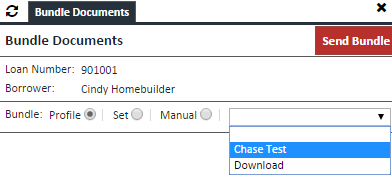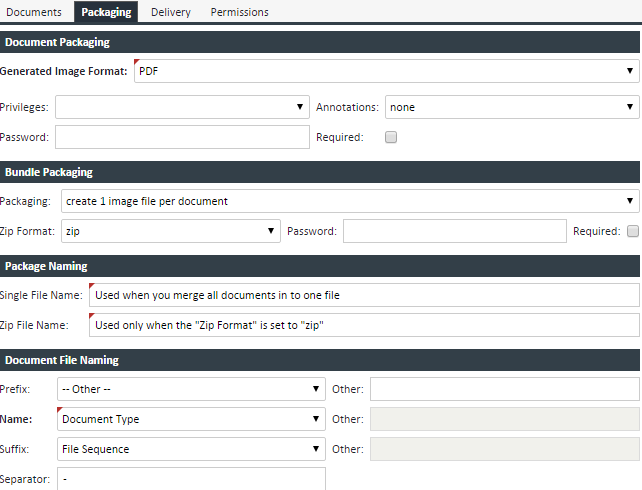Bundle Profiles
Bundle Profiles define where a packaged bundle gets sent. Although a Bundle Profile does have some basic packaging capabilities, we tend to rely on the Bundle Template for packaging. The profiles defined in this section are the profiles that are displayed in the viewer when choosing the Bundle button from the actions bar.

Creating a Bundle Profile
1. From the Bundle Profile page, click CREATE. The Bundle Profile Editor appears.
2. Enter the following information for the available fields
| Field | Description |
|---|---|
| Bundle Profile Editor | |
| Name | Enter a name for your profile |
| Code | Additional Code for your profile. For ease of use, you can use the same information as the Name |
| Description | Enter an addition description, if needed |
| Active | Make sure this says "yes" in order for this to show up in the list of available profiles in the Viewer |
| Sequence | Determines the sort order in the list of Bundle Profiles in the grid |
| Page Errors | Allows XDOC to skip missing or corrupted documents in the bundle. The choices are: a. abort on page load error - XDOC will prevent the bundle from continuing if it encounters any missing/corrupted docs b. ignore non-required page loan errors - XDOC will ignore any missing/corrupted docs if they are not marked as required c ignore all doc page load errors - XDOC will ignore all page load errors, even if the doc is marked as required All docs that are skipped because they are missing or corrupted will be displayed in the bundle execution screen when sending the bundle |
| Template | If using a template for this profile, choose that template here. When you do so you will notice many fields disappear from view, as they are already included in the chosen template |
| Document Tab | |
| Use Documents From Stack | Choose the appropriate document stack here, or choose it manually from the list below. We strongly recommend you always use a stack. |
| Use Document Names From | If using a naming stack, enter it here from the dropdown. A naming stack is a stack you use when the recipient requires the documents to be named with their own names. |
| Manual Document selection | If not using a document stack, manually select the document types from the box on the right and clicking either the "required" or "optional" boxes to move them over. You can also double click the document types in question to move them over. Once all the documents are on the right side, you can order them appropriately with the "Move Up" and "Move Down" buttons. You can select multiple document types by the Ctrl+click and Shift+click methods. You can choose between documents and reference documents with the selector just above the left hand side box.  |
3. The Packaging Tab defines how the documents in the bundle are packaged. The fields are:

| Field | Description |
|---|---|
| Document Packaging | |
| Generated Image Format | Defines how color docs are created (PDF, TIF) |
| Privileges | For PDF delivery, the pdf privileges for the document recipient. NOTE: We highly recommend you leave this blank, as it will grant the recipient all privileges. |
| Annotations | For PDF delivery, the type of annotations that will go with the bundle. Only Permanent and Public annotations can be sent with a bundle. Personal annotations cannot be sent with a bundle. |
| Password | For PDF delivery, defines the password (if any) for the documents |
| Required | If checked, will require the user to enter a zip password when sending the bundle |
| Bundle Packaging | |
| Packaging | Either create one Image file per document or merge all pages into one file |
| ZIP Format | ZIP or none. If you create one Image file per document, you must zip the package |
| Password | Default password for the ZIP file |
| Require | If checked, will require the user to enter a zip password when sending the bundle |
| Package Naming | |
| Single File Naming | Name of the single image file. This is only used when the packaging is set to "merge all documents into 1 image file" |
| Zip File Naming | Name of the Zip file |
| Document File Naming | Each document in the bundle can be named with a prefix, name, and suffix, and each of these fields can be separated by a separator. The dropdown has a list of preconfigured names, or you can choose another name in the "other" column to the right. If the separator is a dash "-" the document name will be prefix-name-suffix.pdf |
| Prefix | The prefix for the file name |
| Name | The middle portion of the file name |
| Suffix | The suffix for the file name |
| Separator | The separator for the prefix, name and suffix fields |
4. The Delivery Sub Tab defines how the package will get sent. The choices are:
a. Download – The user will be prompted to download the file to their desktop
b. HTTP – XDOC will perform an http post to a particular website
c. FTP – Rarely used. Will utilize ftp protocol to deliver file (not secure)
d. File - Will delivery to a network folder. XDOC's IIS Identity user must have permissions to this folder for this to function properly
e. SFTP – By far the most commonly used method to send to outside recipients. The specific instructions for sftp delivery are detailed in the Bundle Template instructions. It is highly advisable that you use a Bundle Template if you're going to send via sftp
5. The Permissions Sub Tab describes the available permissions when sending a bundle created with this profile.
| Field | Description |
|---|---|
| Bundled Documents Allowable Actions | |
| Allow download of bundled documents | At time of delivery, allows overriding the specified delivery type to download the file to the desktop. Very handy for testing. |
| Allow user to override the following when sending the bundle | Options you can override when sending the bundle |
| Document Stacking List | Override the document stack list |
| Custom Properties | Override any custom properties |
| Document Passwords | Override document passwords, if any |
| Document Annotations | Override any annotation settings, if any |
6. When all fields have been completed, click SAVE and test your delivery
